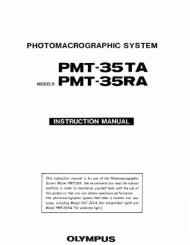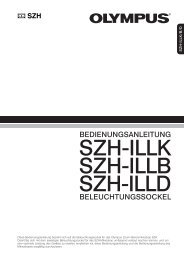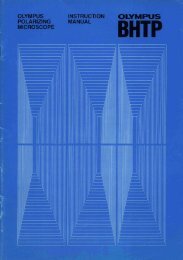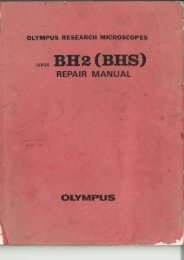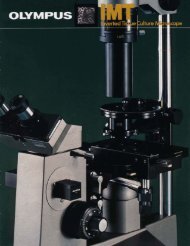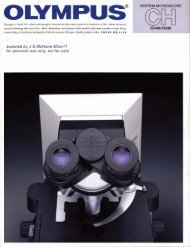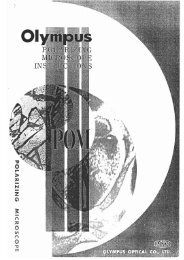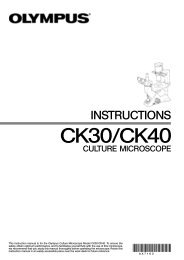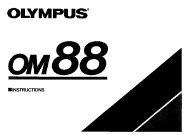Relief Phase Contrast - Olympus CK Series
Relief Phase Contrast - Olympus CK Series
Relief Phase Contrast - Olympus CK Series
Create successful ePaper yourself
Turn your PDF publications into a flip-book with our unique Google optimized e-Paper software.
0 LYMPUS <strong>CK</strong> S E R I E S<br />
GREATER CHOICE IN CELL IMAGING<br />
<strong>Relief</strong> <strong>Phase</strong><br />
Hew-&es <strong>Relief</strong> <strong>Phase</strong> <strong>Contrast</strong> work?<br />
E RPC Theory n <strong>Phase</strong> annulus<br />
The use of oblique <strong>Phase</strong> annulus -<br />
illumination allows a threedimensionally<br />
appearing Condenser<br />
image to be obtained. This<br />
is enhanced by the use of<br />
a filter, resulting<br />
three-dimensional<br />
in superb<br />
<strong>Phase</strong><br />
Specimen<br />
Diffracted light<br />
<strong>Contrast</strong> Images. In<br />
addrtron, the reduced halo Oblecttve<br />
allows more detarled,<br />
effectrve observatron of Modulator<br />
thick specrmens. (In objectrve)<br />
Image<br />
W Modulator<br />
<strong>Phase</strong><br />
0 lrght membrane -<br />
* Filtering one side of<br />
the diffracted light<br />
produces a three-<br />
dimensional image.<br />
objectives<br />
-Faltering<br />
membrane<br />
The reduced halo allows more detailed, &ective observation gf thicker specimens.
;.<br />
‘. .: .(<br />
,.::;,.“, i:./,<br />
: “7<br />
G ‘,:.’ REATER C<br />
.(<br />
: :p<br />
What do you 1 want -. to see-r -<br />
The m: any different requirements of<br />
biomedical microscopists in cell culturing, and<br />
- s,y<br />
the many shapesand sizes of cultured cells,<br />
each provide different imaging problems.<br />
Some microscopists want to visualise cell<br />
edges. Others may only be interested in the<br />
cell’s internal structure. The method you use<br />
. . . will depend on the particular application.<br />
.’<br />
So to provide even more flexibilitv for users,<br />
<strong>Olympus</strong> has incorporated a new <strong>Relief</strong> <strong>Phase</strong><br />
<strong>Contrast</strong> approach in the <strong>CK</strong> Serves<br />
microscopes.<br />
In addition, the <strong>CK</strong> Senes provides for normal<br />
<strong>Phase</strong> <strong>Contrast</strong> with new objectives offering<br />
centering-free alignment with Improved con-<br />
trast and resolution.<br />
Configurations:<br />
<strong>CK</strong>4OF Microscope frame with integrated quadruple revolving<br />
I and plain stage (160xZ50mm), coarse and fine focusing,<br />
long workrng distance condenser NA 0 3, WD 72mm<br />
U-LS30-3-2 Lamp socket 30W<br />
6V30WHAL Halogen bulb<br />
UYCP Power cord<br />
CW3-B145 Binocular tube, 45” inclined<br />
NCWHKlOxil8 Widefield eyepiece, FN 18, option FN 20<br />
1 <strong>CK</strong>40-RPSL Centerable relief phase contrast slider for 4x-20x<br />
magnlflcatron magnification and brIghtfIeld brightfield position<br />
I <strong>CK</strong>40-RPS40 <strong>Relief</strong> phase contrast insert for LWDCPL40xFRP<br />
CT-5LB Centering Telescope<br />
I<br />
H 0 I C E IN c E 1 1 I MAGING<br />
loseoiece<br />
Objectives: Oblectwes:<br />
SPL4xRPI0.13 S Plan Achromat 4x for RPC, WD 15.5mm<br />
DAiOxRPi0.25 DAlOxRPiO 25 D Achromat 10x for RPC, WD 7.18mm 7 18mm<br />
LWDCDA20xRPi0.40<br />
WD 5.4mm<br />
Long working distance D Achromat 20x for RPC,<br />
LWDCDPL40xFRPi0.55 Long working distance D Plan Achroma Achromat t for RPC,<br />
with fixed flxed cover correction (1 .Omm), Omm), WD 2.04mm 2 04mm<br />
I<br />
The double approach of <strong>Relief</strong> <strong>Phase</strong> <strong>Contrast</strong>...<br />
l <strong>Phase</strong> contrast imaging-highlights cell outline and interior<br />
l Oblique illumination-provides volume and conformational information.<br />
. ..provides new imaging strength<br />
l Early detection of changes in cell form and shape<br />
l Particular benefits for cell viability assessments.<br />
<strong>CK</strong> 30<br />
<strong>CK</strong>30F Microscope frame with fixed binocular tube, Integrated quadruple revolwng<br />
nosepiece, plain stage (16Ox250mm), coarse and fine focusing,<br />
long working distance condenser NA 0 3 WD72mm, filter, dust cover<br />
U-LS30-3-2 Lamp socket 30W<br />
6V30WHAL Halogen bulb<br />
UYCP Power cord<br />
NCWHKI Ox/l 8 WIdefIeld eyepiece, FN 18<br />
<strong>CK</strong>40-RPSL Centerable relief phase contrast slider for 4x-20x magnification and<br />
brIghtfield position<br />
<strong>CK</strong>40-RPS40 <strong>Relief</strong> phase contrast Insert for LWDCPL40xFRP<br />
CT 5LB Centering Telescope<br />
Objectives:<br />
SPL4xRPI0.13 S Plan Achromat 4x for RPC, WD 15.5mm<br />
DAlOxRPI0.25 D Achromat 10x for RPC, WD 7.18mm<br />
LWDCDA20xRPi0.40 Long working distance D Achromat 20x for RPC,<br />
WD 5.4mm<br />
LWDCDPL40xFRP/0.55 Long working distance D Plan Achromat for RPC.<br />
with fixed cover correction (1 .Omm), WD 2.04mm<br />
OLYMPUS<br />
THE VISIBLE D I F F E R E N C E



